|
Looking over Dale Luthringers list of
Pennsylvania trees I found that, due to a limited number of
measurements, the tallest Mountain Laurel on the list for
Pennsylvania was just 12.4 feet tall.
I knew there several mountain laurels taller than that
could be found. I
had been wanting to make a measuring pole for field measurements
of shrubs and dwarf trees for some time.
This was the opportunity to do both.
The Mountain Laurel site is in a area known
as the Gas Company Laurel Fields near Clear Creek State
Park in west central Pennsylvania (About 10 miles south of Cook
Forest). This
property was owned by a local natural gas company and covered by
laurel bushes. The
company had cleared most of the trees from the area, leaving the
mountain laurel intact, and mowed part of it forming a small
park-like area. Every
year as part of the Brookville Laurel Festival the area is open
to the public to show off its spectacular display of laurel
blooms. A short Ό
mile dirt road loop allows people to drive around the area or
they can park and walk through the laurel fields.
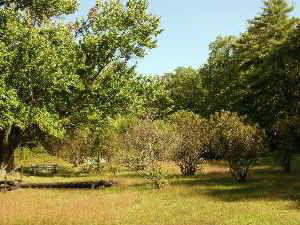
Overview of section of the Gas Company Laurel Fields |
A measuring pole is the ideal way to get
the height for a series of shorter plants - it is essentially a
giant yardstick. The
complexities of the laser rangefinder/clinometer measurements
are not needed. I
made a pole out of two ten-foot pieces of PVC pipe cut into five
foot segments. I
fastened a length of tape from a cheap 16 foot tape measure to
the pole (also cut into sections) and was off to measure the
laurels.
I ended up measuring only six of them,
because their bases were entwined by poison ivy.
I will go back and get more measurements when I get some
help and am wearing some latex gloves.
I took the standard measurements of height and cbh.
I measured the diameter of trunk branch that bore the
tallest sprig at a breast height.
The tallest I measured was 18 4 in height.
Another laurel exhibited the greatest girth 15 and had
a maximum crown spread of 250.
Both the height and girth are larger than those listed in
the PA database.
Laurel 001, height 9 6, cbh 6,
girth 1 foot = 12, ist branch 8, maximum lateral spread
59.
Laurel 002, height 12, cbh 4, girth 1
foot = 9, 1st branch 12, maximum lateral spread
126.
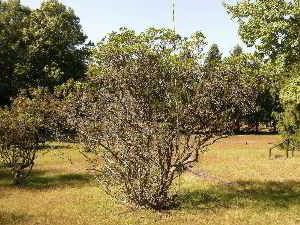
Laurel 003: overview |
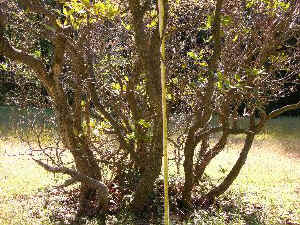
Laurel 003: close-up showing multiple trunks at
base of bush |
Laurel 003, height 13 6, cbh 7, girth 1 foot = 11.1,
1st branch 27, n/a.

Laurel 004: Largest laurel in terms of girth
and spread |
Laurel 004, height 14 6, cbh 15,
girth 1 foot = 18.5, 1st branch 4.5, maximum
lateral spread 130, Max crown spread 250.
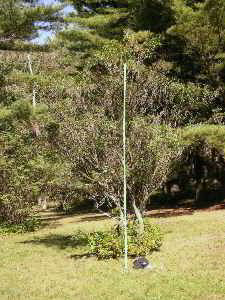
Laurel 005: Tallest measured at 18'
4". Fifteen foot measuring pole provides
scale. There were five main trunks emerging from
the ground in an area about two feet across. |
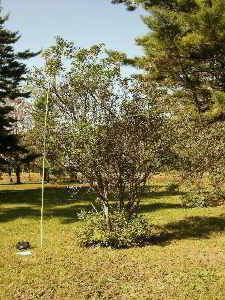
Laurel 005: Side view of the tallest measured
laurel. Fifteen foot measuring pole provides scale |
Laurel 005, height 18 4, cbh
11.75, girth 1 foot 13.5, 1st branch 35,
maximum lateral spread 101, maximum crown spread 174.
Laurel has a typical shrub form with
multiple stems emerge from the ground in a tight clump.
For shrubs or dwarf trees that are short in height, say
average less than 20 feet, it seems inappropriate to measure
their girth at just 4 ½ feet or breast height.
It represents too large of a portion of their total
height. The
figure for cbh provides standardization for tree girth
measurements and should not be abandoned, but girths should also
be measured at height s more appropriate for the particular tree
form or height under consideration.
CBH works well for trees of normal sizes.
It is above the root flair and gives a fair girth
representative of the diameter of the tree before it has tapered
significantly.
For trees like Bald Cypress the root
buttress may extend up the tree for a dozen or more feet and cbh
is not really representative of the diameter of the tree trunk.
For short trees or shrubs the trunk has already tapered
significantly or has split-off several branches resulting in a
trunk diameter that is far to small to be representative.
A five foot tree would likely have its trunk dwindled
down to almost nothing at 4 ½ feet.
For these shrubs and dwarf trees a more appropriate
height would be a 1 foot or above root flair whichever is
higher. In the
listing above I also provided measurement of girth at 1 foot .
I think this should become a standard measurement when
dealing with these shrubs and dwarf tree specimens.
An additional consideration that we should
discuss is how we deal with shrubs like these whos normal
form is that of having multiple trunks emerging from the ground
in a clump. A
useful measure would be to note the number of significant trunks
in the clump and the crown spread of the entire mass.
For the tallest specimen above there were five main
trunks emerging from the ground in an area about two feet across
and the resulting combined crown had a maximum spread of 240.
Ed Frank
Laurel
measurement Data Sheet
|